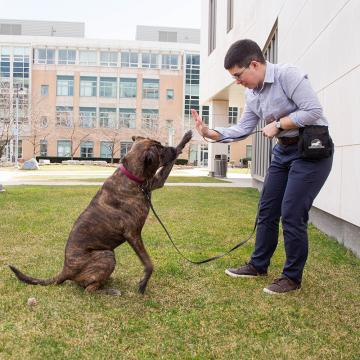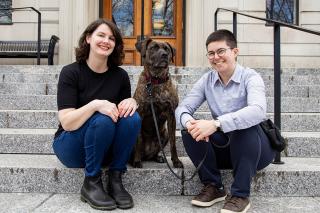As co-founders and co-owners of The Dog Behavior Institute, Ran Courant-Morgan and Dr. Stephanie Keesey-Phelan have found an innovative application for their behavior analysis specialization. We spoke with them about the mission of the Institute, the intrinsic rewards of their profession, and why they chose Simmons.
“The overarching mission of The Dog Behavior Institute is to apply behavior analysis to our work with dogs and their families to promote more joyful interactions and more joyful relationships,” says Dr. Stephanie Keesey-Phelan ’13MS, ’20PhD, co-owner and co-founder of the Institute.
“We also work with other dog trainers to help them strengthen their behavior analytic knowledge,” adds co-owner and co-founder Ran Courant-Morgan ’13MS.
For Courant-Morgan and Keesey-Phelan, who both pursued graduate studies in Behavior Analysis at Simmons, bringing the science of their discipline to dog behavior is what sets them apart from other dog training organizations.
De-pathologizing Dog Behavior
The Dog Behavior Institute’s unique approach does not attempt to fix a dog’s “problems.” Keesey-Phelan explains: “We know that all behavior is a function of what transpires in the environment. Our clients want a more positive relationship with their dogs, so we address how their dogs can learn within their specific environment.” As Courant-Morgan continues: “The idea of fixing a behavior is often intertwined with a preconceived notion that there is a ‘right way’ to be in this world, which is not true. In the realm of dog behavior, some behaviors might be problematic in some contexts, but enjoyable in others. There are very few behaviors that are universally bad. In our services, we consider what clients and their dogs need, and what kind of expectations they can abandon. Then we have a discussion and craft a plan to implement these changes.”

In their practice, Courant-Morgan and Keesey-Phelan observe many cases of aggression and reactivity (especially toward other dogs or people) as well as resource guarding (i.e., dogs becoming overly protective of food or toys). “We work with dogs and their guardians to address these behaviors. I also help families prepare for the arrival of a new baby, and Stephanie addresses dogs challenged by separation anxiety through a rigorous desensitization protocol,” explains Courant-Morgan.
The co-owners love the scientific aspect of their practice. “As scientists, we love data, and we incorporate data collection into everything that we do, which is another way our practice differs from that of traditional dog training. Our work and recommendations are based on the analysis of what is happening for the individual dog and their context, and we find that by being objective in this way, we can work with our clients toward a specific goal,” says Keesey-Phelan.
While there is relatively little published research on behavior analysis vis-à-vis animals, Courant-Morgan and Keesey-Phelan import key insights from behavior analysis into their practice, with measurable success. “An enormous strength of behavior analysis is that we are always looking at the function of behavior. Every behavior happens for a reason, and it is reinforced in some particular way. If we can determine why that behavior is happening and being reinforced, we can use that reinforcer to strengthen other desired behaviors. For example, if a dog jumps in a problematic way, we may identify that this dog jumps to receive attention. Rather than denying the dog attention, which may cause a number of negative side effects, we devise another way that the dog can request attention. This is just one possible plan but it highlights how we analyze the dog’s behavior in their environment and teach new skills that best benefit dogs and their guardians,” explains Courant-Morgan.
“People may think that we need to punish behaviors that are undesirable in order for change to happen,” they add. “On the contrary, there is copious evidence that change can occur by addressing behavior through positive reinforcement. As a result, we have found a behavior analytic approach is not only more effective but also more humane.”
Studying at Simmons
“I do not think we would be doing what we are doing today if it had not been for the Behavior Analysis program at Simmons,” says Courant-Morgan.
After years of working in the veterinary field and at animal shelters, Courant-Morgan decided to become a dog trainer. When searching for certification programs, they came upon the Master of Science in Behavior Analysis at Simmons. “Shortly thereafter, I met Stephanie, and we discussed our professional goals. We both applied to Simmons and got accepted,” recounts Courant-Morgan.
“I wanted to study behavior analysis and apply it to dogs, but I wanted to ‘do it right,’” explains Keesey-Phelan. “In other words, I wanted a program that had some heft behind it and was grounded in science. Dog training is not a regulated industry, so anyone can decide to become a dog trainer with or without education and experience.” Keesey-Phelan continued her studies at Simmons at the doctoral level.
Although Simmons did not offer a specific behavior analytic concentration for animal subjects, Keesey-Phelan and Courant-Morgan tailored their studies accordingly, conducting research projects, literature reviews, and data collection on animals. “Being able to ask my professors and classmates questions was invaluable and cultivated the confidence I have now. Simmons gave me a good foundation and introduced me to resources regarding effective and ethical approaches that I could employ when working with dogs,” says Courant-Morgan.
Finding Fulfillment
Both co-owners of the Institute find their work incredibly rewarding, both personally and professionally. “I remember fondly the many moments with different clients when we saw things click. We witness the dog suddenly doing something on which we have coached them, and they seem to tell us, ‘Ok, I’ve done it, where’s my treat?’ And then they wag their tail and this brings me so much joy,” says Courant-Morgan.
“I especially like working on the separation anxiety cases to help dogs who have trouble when left alone,” says Keesey-Phelan. “We work with them very gradually, starting with them being alone for just a few seconds or minutes at a time. It’s a slow process but with consistent work over time these dogs who struggled so much can be left alone comfortably. Guardians report such joy and relief. That people can get their lives back and are no longer panicked about leaving their dogs alone — it has been profoundly gratifying.”
Courant-Morgan enjoys the research-based and creative-minded work that their profession affords. “We also write a blog and remain active on social media, in addition to offering courses and conducting scholarly research. There are so many opportunities for us to engage our intellectual and creative faculties, and we both get to enjoy and celebrate our own dogs as well.”
“We donate part of our revenue to local [and sometimes national and international] organizations that are doing admirable work, such as Rosie’s Place and BAGLY (The Boston Alliance of LGBTQ+ Youth),” adds Keesey-Phelan. “We also provide free resources, including talks at local libraries and veterinary practices. As small business owners, it is important for us to give back to our communities.”
While running a small business poses its own challenges, the co-owners have a harmonious working relationship. “I can be very nerdy around Stephanie as we analyze and theorize about dog behavior,” explains Courant-Morgan. “Ran always encourages me to be my best self,” says Keesey-Phelan. “That has been a huge part of why I love what I do and what keeps me going.”

